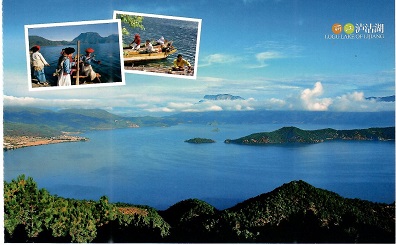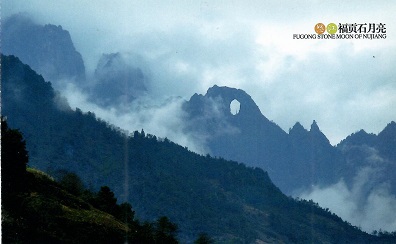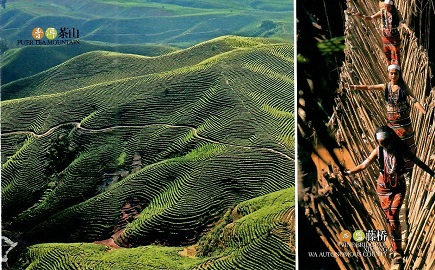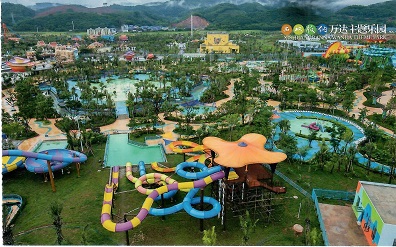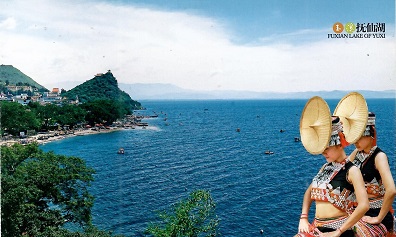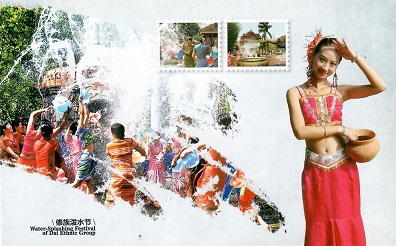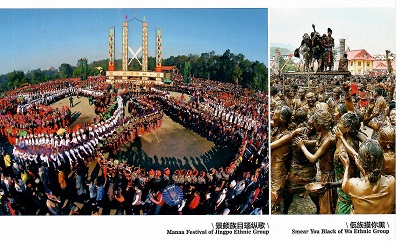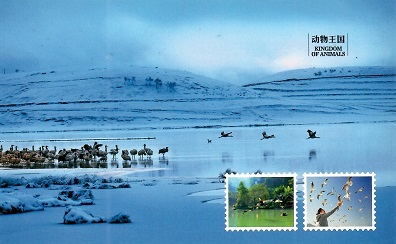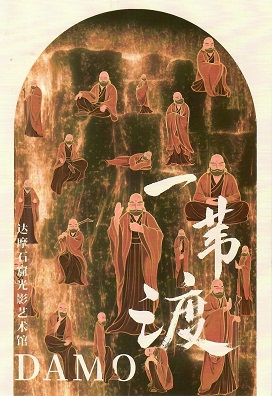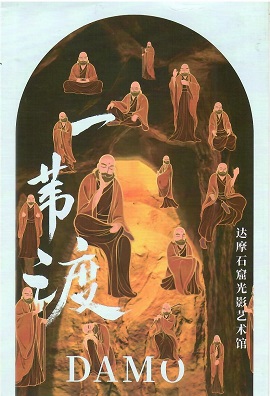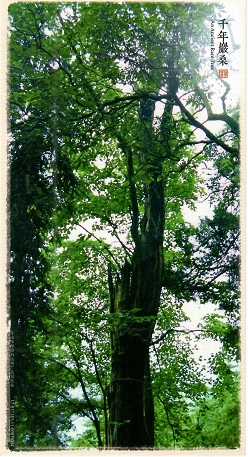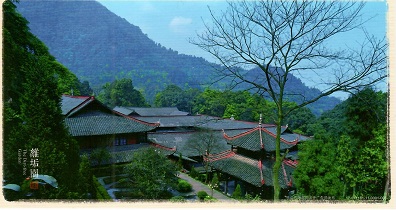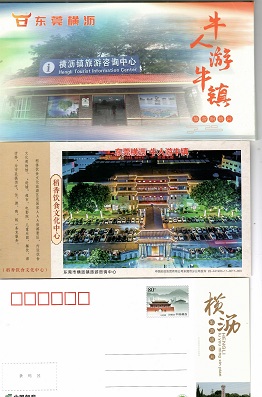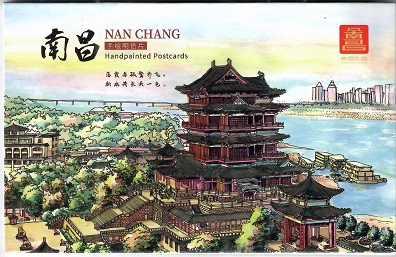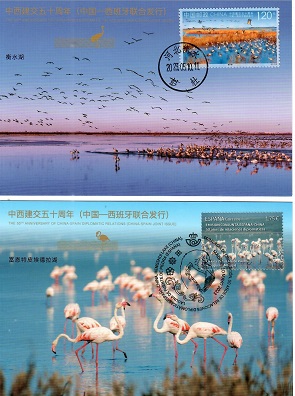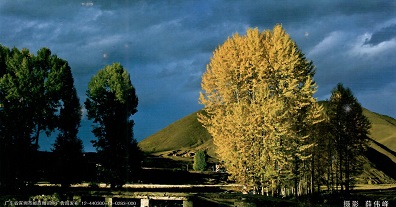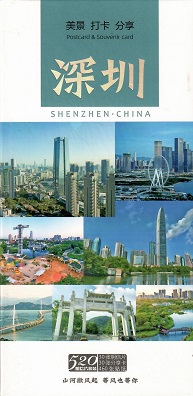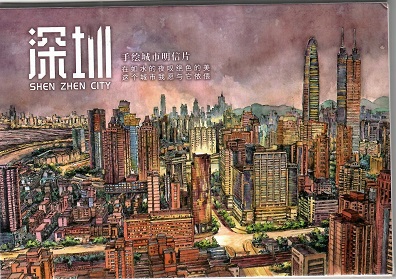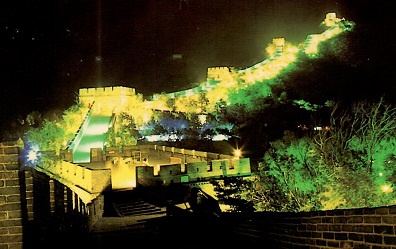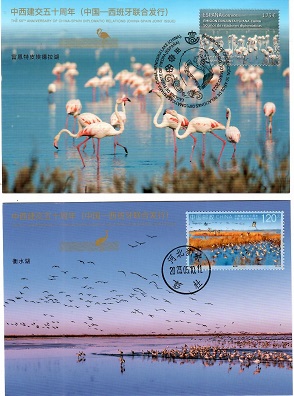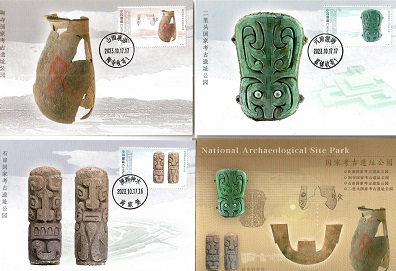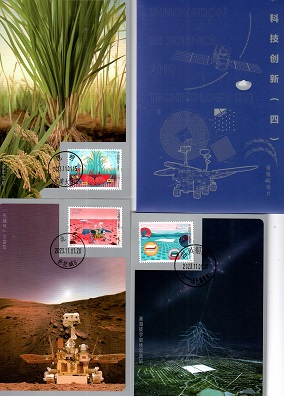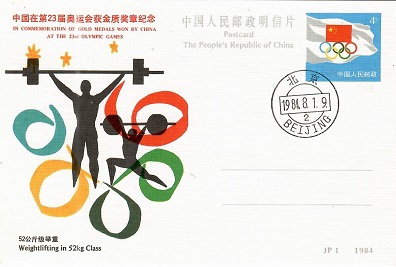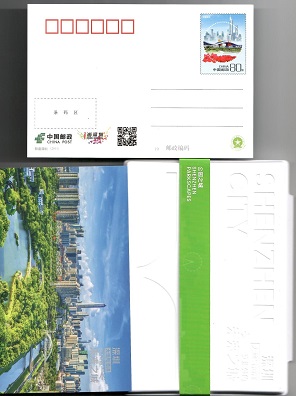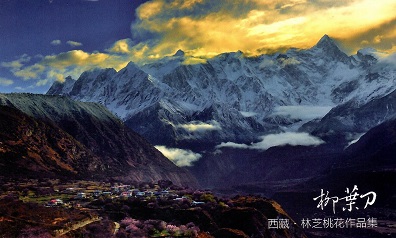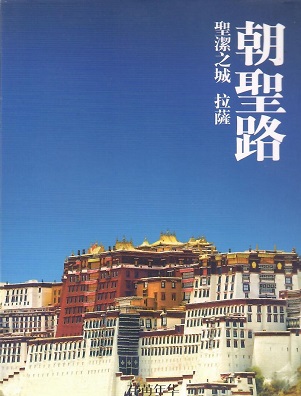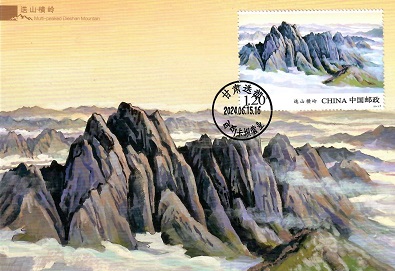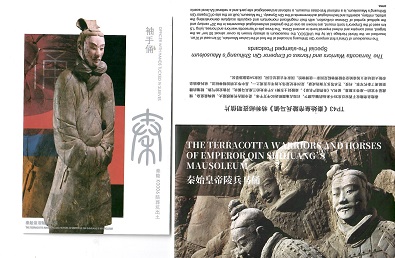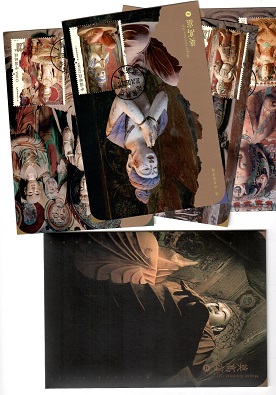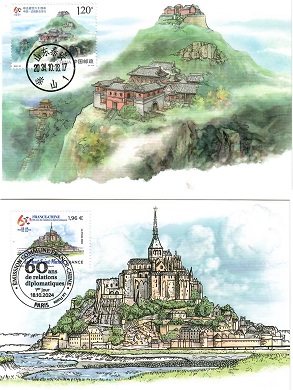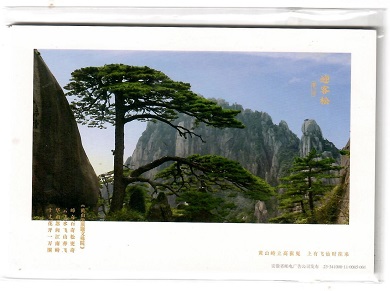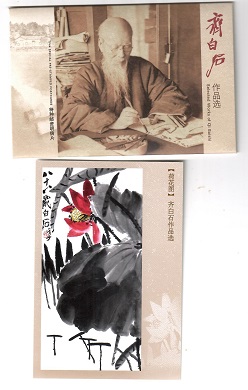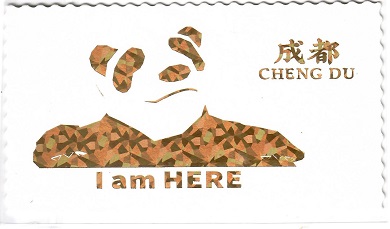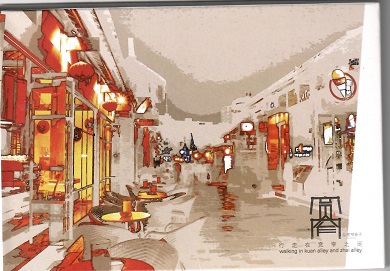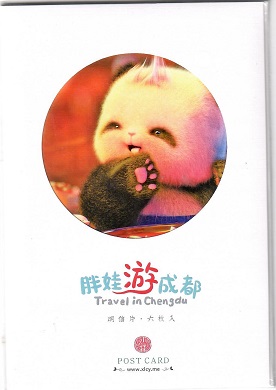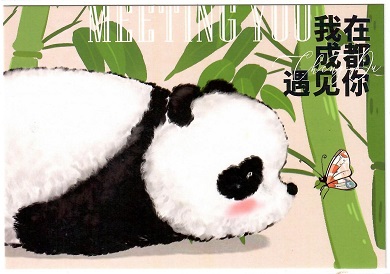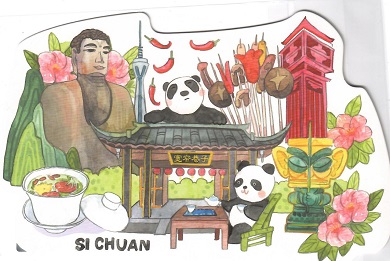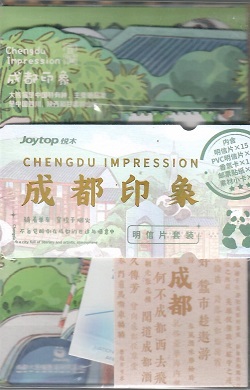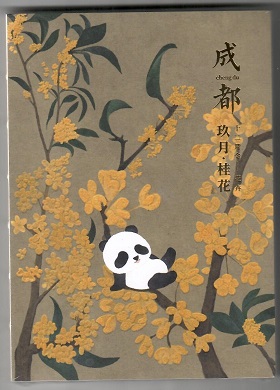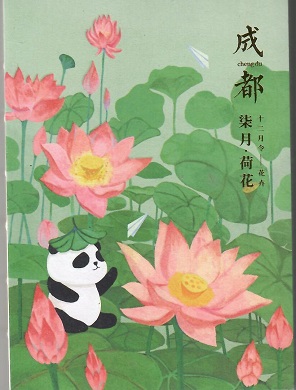-
Yunnan – Lugu Lake of Lijiang
From the Yunnan series, this unused card whose feature (the lake) is so distinctive that we will give you a condensed Wikipedia description of it: “Lugu is called the ‘mother lake’ by the Mosuo people. The lake is also well-known in Chinese travel pamphlets as the region of “Amazons,” “The Kingdom of Women” and “Home of the Matriarchal Tribe”, this last name highlighting the dominant role of the Mosuo women in their society. It is also known as “A Quaint Realm of Matriarchy.” The matriarchal and matrilineal society of the Mosuos is also termed the “Women’s World” … and this goes on, but you get the idea. QR Codes are there. Grade: 1
-
Yunnan – Fugong Stone Moon of Nujiang
An unused card with perforated left edge from the Yunnan set as described earlier. Two QR Codes are available for more information about this striking province. Grade: 1
-
Yunnan – Pu-er Tea Mountain and Vine Bridge
An unused card with perforated left edge from the Yunnan set as described earlier. Two QR Codes are available and two scenes here, an impressive mountain of tea and the Vine Bridge of Ximeng in Wa Autonomous County. Grade: 1
-
Yunnan – Xishuangbanna Wanda Theme Park
An unused card with perforated left edge from the Yunnan set as described earlier. Two QR Codes are available and there’s plenty online about this gigantic theme park. Grade: 1
-
Yunnan – Fuxian Lake of Yuxi
Fuxian Lake (抚仙湖) stretches through Chengjiang, Jiangchuan and Huaning Counties in Yunnan Province, spanning an area of 212 square kilometers. The lake is ranked third-largest in Yunnan, after Dian and Erhai Lakes. Also the deepest lake in Yunnan, it is 155 meters deep at its greatest depth and also the third-deepest fresh water lake in China, after Tianchi and Kanas Lakes. This unused card with left perforated edge comes from the Yunnan set described earlier, with two QR Codes. Grade: 1
-
Yunnan – Water-Splashing Festival of Dai Ethnic Group
Another unused card from the Yunnan series: left perforated edge, but this card only has one QR Code. What look like stamps on the front are not stamps — just part of the design. Grade: 1
-
Yunnan – Jingpo and Wa Ethnic Groups
From the Yunnan set with left perforated edges and QR Codes (just one this time), an unused card celebrating two events: Manau Festival of Jingpo Ethnic Group, and the elegantly named “Smear You Black” of Wa Ethnic Group. Wow! Grade: 1
-
Yunnan – Kingdom of Animals
The last of our series of Yunnan cards from the set, and they have perforated left edges. This unused example has one QR Code, and those stamp-like photos on the front are not stamps, but part of the design. Grade: 1
-
Damo (A)
First, some Wikipedia information about the subject: “Bodhidharma was a semi-legendary Buddhist monk who lived during the 5th or 6th century CE. He is traditionally credited as the transmitter of Chan Buddhism to China, and is regarded as its first Chinese patriarch. According to a 17th-century apocryphal story found in a manual called Yijin Jing, he began the physical training of the monks of Shaolin Monastery that led to the creation of Shaolin kungfu. He is known as Dámó in China … Little contemporary biographical information on Bodhidharma is available, and subsequent accounts became layered with legend and unreliable details. According to principal Chinese sources, Bodhidharma came from the Western Regions, either Central Asia or the Indian subcontinent, and is described as either a ‘Persian Central Asian’ or a ‘South Indian […] the third son of a great Indian king.’ Throughout Buddhist art, Bodhidharma is depicted as an ill-tempered, large-nosed, profusely-bearded, wide-eyed non-Chinese person. He is referred to as ‘The Blue-Eyed Barbarian’ (碧眼胡).” We know that’s a lot to take in but this and the following card are also unusual, unused, and issued officially by China Post. The QR Code will likely tell you even more. Grade: 1
-
Damo (B)
See previous card 20307963 for a complete explanation. This one, not the same, is also unused. Grade: 1
-
An Ancient Rare Tree
This unusual unused postcard hides all its secrets in plain sight. To start, the card measures 4″ x 7-1/4″. Our header is the card’s caption, on front and reverse. But there’s more, in faint letters, and we will put it all here: “The Latin name of this tree is Morus cathayana Hemsl. It lives on Guanxin Slope, 1200 meters above sea level, and has witnessed a history of over 700 years. Greetings from Mt. Emei, a World Heritage site.” This is an official China Post card and had an uncancelled stamp affixed at point of origin. All we can suggest is that the Chinese Government should not tell anyone exactly where the tree is. Grade: 1
-
Ligou Garden
Elements of previous card 20307965 are the same here: unused, stamped, official, Mt. Emei, Greetings, and World Heritage — and measuring 4″ x 7-1/4″. In this case, as the old saying goes, the card’s caption takes the cake: “Ligou Garden, or the Dirt-free Garden, sits among the trees in Fuhu Temple (“Tiger Taming Temple”). Nearly no dead leaf would ever fall on the roofs of the garden because of its unique architectural designs. This is considered a wonder in the world history of architecture.” Either that, or a clean-up squad appears in the middle of the night to exact its own wonders. Grade: 1
-
Hengli (set of 12)
Published by China Post, and with pre-printed colour postage, the 12 unused cards in this 2009 set are captioned entirely in Chinese. Our scan shows the front cardboard cover, the front of one card, and the back of another. Grade: 1
-
Nan Chang (set of 10)
These 10 unused cards — artwork, not photographs — come in a cardboard cover whose front you see in our scan. (That design is also on one of the postcards.) Captioned in Chinese only, so your Google Translate will get a workout. Grade: 1
-
50th Anniversary of China/Spain Diplomatic Relations (Maximum Cards) (set of 2)
Issued by China Post as Maximum Card set MC-134, these two cards are distinctly Chinese notwithstanding the Spanish stamp on one of them. Unused. Grade: 1
-
Shenzhen Postal Bureau
A nice enough scene on this 4″ x 7-1/4″ lottery card from China Post in Shenzhen in 2012, but there’s no English caption, and what Chinese there is does not identify the location. Unused, with pre-printed postage and individual lottery number, and we have several of these. It is too late to redeem your winnings, though. Grades: 1
-
Shenzhen (pack of 30+)
As you might know, Shenzhen transforms itself almost by the minute. This jumbo pack of 30 postcards, 30 “share” cards and what might be 460 small stickers was sourced in late 2023 and is still in its original cellowrap, so we don’t know what appears on the cards. However we do know the reverse of the pack has a long description — Chinese only — telling of many of Shenzhen’s visual and gustatory attractions. If you are looking for one comprehensive item showing Shenzhen up to that date, this would probably be it. The scan of the front of the pack should give you some idea. Grade: 1
-
Shen Zhen City (Set of 10)
An unused set of 10 cards — detailed artwork, not photographs — showing various scenes around the city. The set has a cardboard cover, which itself has thumbnail shots of each card. Grade: 1
-
The Great Wall at Badaling
When it’s a night view like this, you don’t see the many thousands of people and vendors surrounding the area. We’ve already commented that, for a few renminbi more, it’s much better to go to the Mutianyu entrance further north. This postcard was not postally used but has a message covering the reverse. Grade: 4
-
50th Anniversary of China-Spain Diplomatic Relations (Maximum Cards) (set of 2)
Issued as set MC-134 by China Philatelic in 2023, both cards feature flamingos but one is stamped and postmarked as China, while the other, naturally, represents Spain. Grade: 1
-
National Archaeological Site Park (Maximum Cards) (set of 4)
Here is China National Philatelic’s 2023 set MC-137 of four maximum cards showing (and identifying in Chinese) various archaeological artifacts. Our scan shows the front of the cardboard cover at the lower right, and three of the four cards. Grade: 1
-
Innovation in Science and Technology (IV) (Maximum Cards) (Set of 5)
The cardboard cover for this set of five maximum cards appears in the top right of our scan, along with most of three of those five cards. It’s China National Philatelic set MC-138 from 2023, and the cards show experimental rice, the Mars Rover, a cosmic ray observatory, a satellite, and … artificial starch. Definitely an outer-space theme. Grade: 1
-
23rd Olympic Games, Weightlifting in 52kg Class
You might refer back to our entry 20307940 for a similar card (different sport) but otherwise identical description, which we’ll repeat here: Maybe lesser-known among Olympics postcards, but a simple example issued by the Chinese Government “In commemoration of gold medals won by China at the 23rd Olympic Games”. Postmarked August 1984, with pre-printed coloured postage. The reverse is blank. Grade: 1
-
Shenzhen City (5 sets of 10 cards each)
We debated the best way to post these, and settled on what you see here. Five sets of cards show aspects of Shenzhen. Each set has its own theme: Shenzhen Parkscapes, Shenzhen Heritages, Shenzhen Kaleidoscope, Shenzhen Architectures, and Shenzhen Azure. Each set comes in a plastic container (see lower right of our scan) encircled by a paper wrap with appropriate title. The rest of the scan shows typical front and reverse of one of the cards in each set. They are still in their original cello-wrap. Sets may date from about 2012 and would — we think — be definitive of the city at the time. We decided not to break up this “set of sets” because it deserves to stay together, but we have not opened all the wrappers to verify everything — they came direct from a China Post unit. So if you are interested, you either accept them as they are or we can open them for you to verify each has its own 10 cards. In the event, total cost is for all five sets; everything is Grade: 1
-
Lhasa (Tibet), Holy City, Pilgrimage Road Set
This is an unopened set of cards, in the original cello-wrap, showing what may be 30 scenes of Potala Palace and other notable sights in and around Lhasa. We base our estimate of 30 cards on the 30 thumbnail shots on the reverse of the cardboard cover, which we will scan and e-mail to you if you are interested. All text on the outer cover is in Chinese. Grade: 1
-
Qinling Mountains (Maximum Cards) (Set of 9)
Set MC-139 of nine maximum cards from China National Philatelic, issued in 2024 and captioned entirely in Chinese, all in a sort of plastic sleeve. You can see one of the cards here. QR codes and bar codes may help you decipher the details. As mountain postcards go, this is really a very nice set. The Qinling (秦岭) or Qin Mountains, formerly known as the Nanshan (“Southern Mountains”), are a major east–west mountain range in southern Shaanxi Province, and mark the divide between the drainage basins of the Yangtze and Yellow River systems, providing a natural boundary between North and South China. Grade: 1
-
Terracotta Warriors and Horses of Emperor Shihuang’s Mausoleum (Set of 5)
Our scan shows you one of the five cards, and most (not all) of the cardboard cover for this set TP43, issued by China Post and fully captioned in English and Chinese. Each card has a different, pre-printed, coloured stamp somewhat matching the main photo. AND, each card has an individual (i.e., for the set) serial number: this set is #0029924. Grade: 1
-
Mogao Grottoes (Maximum Cards) (Set of 4)
From Wikipedia (edited): “The Mogao Caves, also known as the Thousand Buddha Grottoes, form a system of 500 temples, 25 km (16 mi) southeast of the center of Dunhuang, on the Silk Road, in Gansu province. The caves may also be known as the Dunhuang Caves; however, this term is also used as a collective term to include other Buddhist cave sites in and around that area, such as the Western Thousand Buddha Caves, Eastern Thousand Buddha Caves, Yulin Caves, and Five Temple Caves. The caves contain some of the finest examples of Buddhist art, spanning a period of 2,000 years.” Our scan shows parts of the four cards, issued by China National Philatelic in 2024 as set MC-140, and the cardboard cover. Grade: 1
-
Joint PRC/France Issue (Set of 2) (Maximum Cards)
From 2024, a 2-card set published from the PRC side, with one stamped and postmarked in Chinese and the other in French. Officially, it’s China Post’s set MC-141. Grade: 1
-
Huangshan views (Set of 6)
This is an unopened set of six unused cards, all with coloured pre-printed postage, from China Post. They originated from the Huangshan Huaxu Tourism Culture and Creative Co., and while we have not seen all six views, one is of the Wenshu Temple, and one Chinese line translates as “Jieshi Strange Pine Trees are Even Stranger”. We don’t doubt that. Grade: 1
-
Qi Baishi (Set of 4)
Qi Baishi, a Hunan native, was a master of Chinese painting, calligraphy, and seal engraving in 20th-century China. This (unused) China Post set TP-44 of four cards, with coloured pre-printed postage, displays his work: our scan shows the cover and one of those cards. Somewhat exceptionally, there’s an extensive English explanation. Grade: 1
-
Cheng Du, I am HERE
A sign now prominent in one of Chengdu’s airports says, roughly, “Chengdu is more than pandas”. That is true, but thanks to the Panda Conservation Center, one cannot go anywhere in the city without a panda reminder. Like this card: unused, 4″ x 7-1/8″, and all that gold colour has a shiny foil effect. Grade: 1
-
Walking in Kuan Alley and Zhai Alley (set of 12)
Kuan (alternatively: Kwan) Alley and Zhai Alley get combined into one name for touristic purposes, and connote different eras to different people. As a single street loaded with shops and restaurants, especially at night it’s an unbeatable attraction in the middle of Chengdu. Our scan shows you the artwork on the cover of this set of 12 unused cards, but the cards are photos, mostly of historical sites that predated the shops. Grade: 1
-
Travel in Chengdu (set of 6)
Based on the six thumbnail photos on the back cover of this unopened set, we assume that’s the correct number of cards. Each is a variation on the humorous panda art you see in our scan, just more elaborate. Grade: 1
-
Meeting You in Cheng Du
Unused card in its original cello-wrap sleeve. Grade: 1
-
Si Chuan, multiple icons
Actually Sichuan has three prominent icons: pandas, pandas, and more pandas. This is an unused card, cut in an irregular shape, measuring about 4-3/4″ x 7-1/2″ and still in its original sleeve. Grade: 1
-
Chengdu Impression (set of many)
This is an unused, unopened (in cello-wrap) set of items in a small (4″ x 5-3/4″) plastic box. The back of the sleeve shows tiny thumbnails of what the circular front logo promises: “15 postcards, 1 PVC postcard, 1 Fragrance card, 6 Stamp stickers, 5 Material photocards …” and while we cannot verify this, we have no reason to doubt it even if we don’t know what those are. Grade: 1
-
Chengdu Nine-Yue Osmanthus (set)
With apologies, we have no idea what this is, but we will tell you what we know: it (and its companion piece 20307994) is still firmly sealed in cello-wrap, unopened. The gold-leaf title on the front translates as our title shows, making it sound like a flowered tea, but it came from a postcard shop in Chengdu. The reverse attributes this to “Sanhua Acdemy”, for which Google does lead to that bookstore/shop. A poem on the back cover says: “The beauty of Chengdu lies in the details. The flower of Jincheng, beauty in time and space, There are flowers in the history of Chengdu. There are flowers in poetry and there are flowers in time.” And we very much hope there are postcards in this item, but, to repeat, we don’t know! Having said all that, it looks really nice. Grade: 1
-
Chengdu July Moon, Lotus (set)
Please refer to our previous entry 20307993. The same comments apply. Special discount if you want both. Grade: 1

